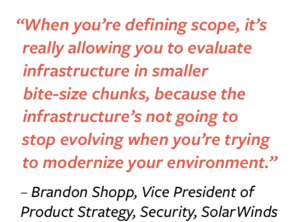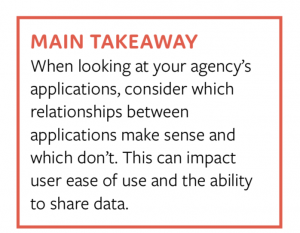This article is an excerpt from GovLoop’s recent guide, “Intelligent Innovation: Tech Trends Taking Root in State and Local Governments.” Download the full guide here.
Any well-constructed business will have a detailed account of its inventory and management policies. It shouldn’t come as a surprise that smart government at the state and local level requires the same.
The assortment of IT solutions that state and local agencies acquire can resemble something of a patchwork quilt. What one administration procured can be in direct opposition to the vision of another, and the result is a system that contains different generations of solutions that are hard to monitor and track.
Governments aren’t given any special leniency when it comes to managing these applications and modernizing their legacy systems, however. GovLoop recently interviewed Brandon Shopp, Vice President of Product Strategy, Security at SolarWinds, to learn how state and local agencies can manage and modernize their systems in dangerously outdated and muddled IT networks. With SolarWinds solutions, they can monitor and manage their IT solutions with greater visibility.
“There are going to be people that are provisioning things, and they’re not always communicating with everybody. The left hand doesn’t know what the right hand is necessarily always doing,” Shopp said.
Monitoring IT networks is critical for state and local governments that are modernizing their IT in order to coordinate actions and track their ownership of solutions. Across government, duplication and lack of interoperability have chronically posed problems.

Visibility is paramount for cybersecurity as well. By understanding what is in their environment, state and local governments are able to appropriately monitor for vulnerabilities and other risks.
SolarWinds IT Management and Monitoring solutions offer agencies the flexibility to monitor their products and automate processes, reporting highly detailed feedback throughout. The solutions are built to track the status of systems across environments, whether on-premise or in the cloud, and can designate specific solutions for modernization.
“When you’re defining scope, it’s really allowing you to evaluate infrastructure in smaller bite-size chunks, because the infrastructure’s not going to stop evolving when you’re trying to modernize your environment,” Shopp said.
Along the road to modernization, state and local governments need to define the scope of projects, take inventory, conduct a needs analysis, survey the market and move forward with initiatives – considering security throughout the process. Following these steps, they can create a ranking of projects and start down a realistic path to a cohesive IT environment.


